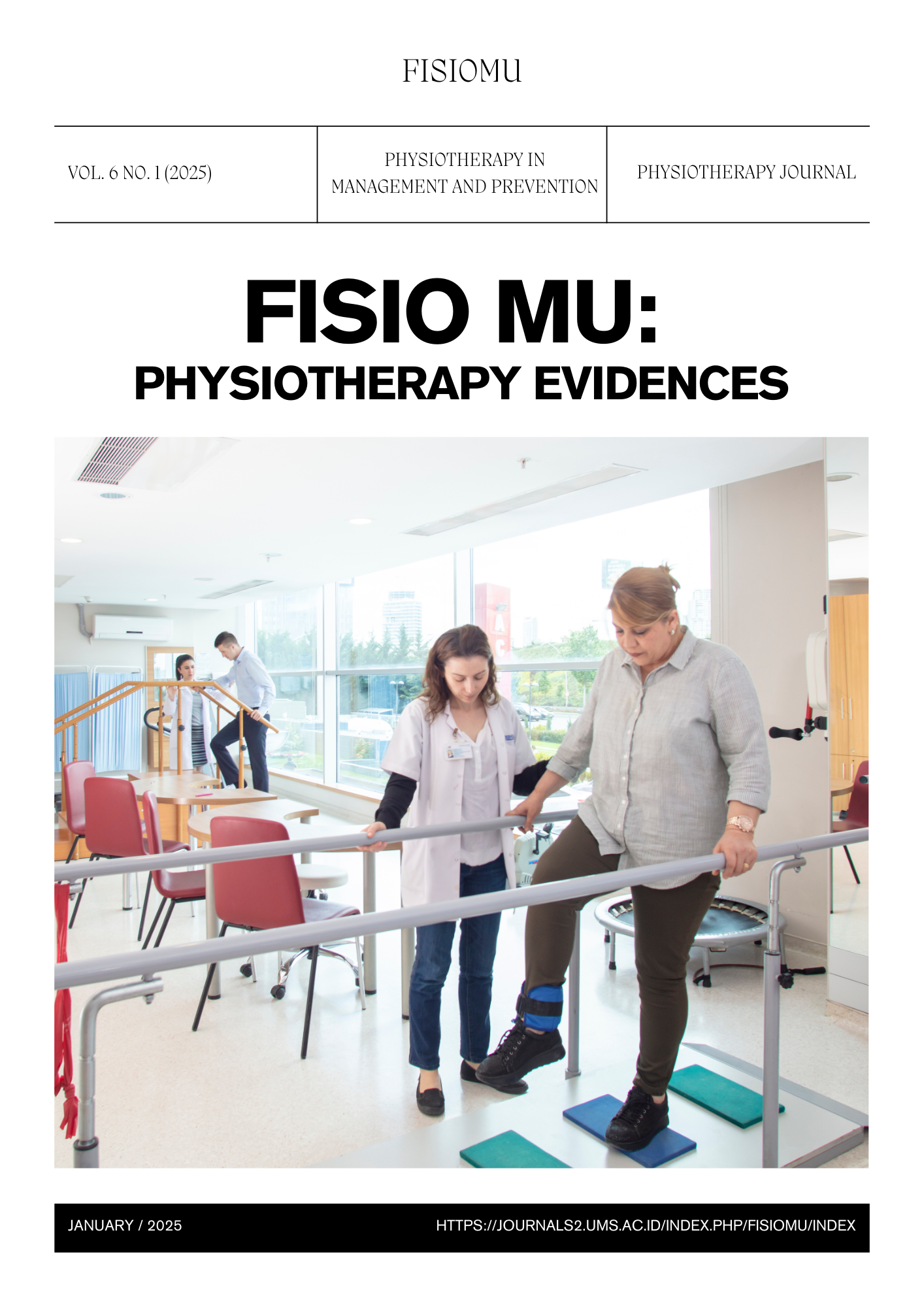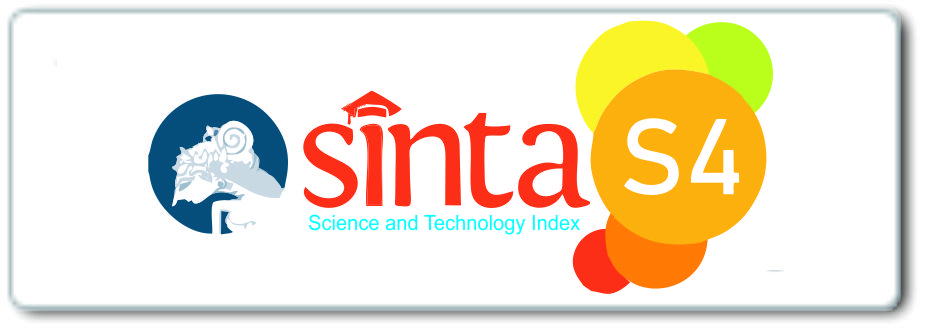Effectiveness of Motor Relearning Program in Improving Walking Ability of Post-Stroke Patients: Meta-Analysis
DOI:
https://doi.org/10.23917/fisiomu.v6i1.5619Abstract
Introduction: Stroke is a disorder of brain function due to rupture or blockage of blood vessels in the brain. To collect and analyze previous studies related to the improvement of walking ability of post-stroke patients with MRP intervention compared with functional training. Methods: The meta-analysis method by sourcing seven research articles that were searched using PICO criteria consisting of population, namely post-stroke patients, intervention provided, namely Motor Relearning Program, and comparisons in the form of functional training with outcomes of improved walking ability. Keywords used in searching articles are “Motor Relearning Program”, “stroke”, and “randomised controlled trial” through a database in the form of Google Scholar. Data was processed using the Review Manager application (RevMan 5.3). Results: There was an increase in walking ability in stroke patients who were given a motor relearning program by 1.83 units compared to patients who were given functional training (SMD = 1.83; 95% CI = 0.01 to 3.65) and the results were statistically significant (p <0.00001). The heterogeneity of the study data showed I2= 97% (random effect model). Conclusion: A Motor Relearning Program (MRP) is more effective than functional training in improving walking ability in post-stroke patients.
Downloads
References
Adi, D. P., Herawati, I., & Ariyani, A. (2023). Fisioterapi untuk Meningkatkan Keseimbangan Pasien Hemiparese Pasca Stroke Non Hemoragik: Studi Kasus. Journal of Innovation Research and Knowledge, 2(9), 3371-3378.
Bhalerao, G., Kulkami, V., & Kapoor, D. (2011). Acute Stroke Rehabilitation : Motor Relearning Program Versus Bobath Approach . Journal of Orthopaedics and Rehabilitation, 1(1), 79–88.
Bhalerao, G., Kulkarni, V., Doshi, C., Rairikar, S., Shyam, A., & Sanchet, P. (2013). Comparison of Motor Relearning Program Versus Bobath Approach At Every Two Weeks Interval for Improving Activiti. 3(3), 70–77.
Cashin, A. G., & McAuley, J. H. (2020). Clinimetrics: Physiotherapy Evidence Database (PEDro) Scale. Journal of Physiotherapy, 66(1), 59. https://doi.org/10.1016/j.jphys.2019.08.005 DOI: https://doi.org/10.1016/j.jphys.2019.08.005
Chen, L., Xiong, S., Liu, Y., Lin, M., Zhu, L., Zhong, R., Zhao, J., Liu, W., Wang, J., & Shang, X. (2018). ARTICLE IN PRESS Comparison of Motor Relearning Program versus Bobath Approach for Prevention of Poststroke Apathy : A Randomized Controlled Trial. Journal of Stroke and Cerebrovascular Diseases. https://doi.org/10.1016/j.jstrokecerebrovasdis.2018.11.011 DOI: https://doi.org/10.1016/j.jstrokecerebrovasdis.2018.11.011
Diah Purnamayanti, N. K., Pari Usemahu, N. Y., M, F. H., & Layun, M. K. (2020). Aplikasi Latihan Rentang Gerak Dengan Berbagai Pendekatan Pada Pasien Stroke. Jurnal Kesehatan, 13(1), 22–34. https://doi.org/10.23917/jk.v13i1.11098 DOI: https://doi.org/10.23917/jk.v13i1.11098
Feigin, V. L., Brainin, M., Norrving, B., Martins, S., Sacco, R. L., Hacke, W., Fisher, M., Pandian, J., & Lindsay, P. (2022). World Stroke Organization (WSO): Global Stroke Fact Sheet 2022. International Journal of Stroke, 17(1), 18–29. https://doi.org/10.1177/17474930211065917 DOI: https://doi.org/10.1177/17474930211065917
Ghrouz, A., Guillen-Sola, A., Morgado-Perez, A., Muñoz-Redondo, E., Ramírez-Fuentes, C., Curbelo Peña, Y., & Duarte, E. (2023). The effect of a motor relearning on balance and postural control in patients after stroke: An open-label randomized controlled trial. European Stroke Journal. https://doi.org/10.1177/23969873231220218 DOI: https://doi.org/10.1177/23969873231220218
Hasbiah, H., & Ahmad, H. (2021). Beda Efek Pemberian Motor Relearning Program Dan Pemberian Proprioceptive Neuromuskular Facilitation Terhadap Peningkatan Kemampuan Fungsional Penderita Post Stroke. Media Kesehatan Politeknik Kesehatan Makassar, 16(1), 17. https://doi.org/10.32382/medkes.v16i1.1988 DOI: https://doi.org/10.32382/medkes.v16i1.1988
Johnson, W., Onuma, O., Owolabi, M., & Sachdev, S. (2016). Stroke: A global response is needed. Bulletin of the World Health Organization, 94(9), 634A-635A. https://doi.org/10.2471/BLT.16.181636 DOI: https://doi.org/10.2471/BLT.16.181636
Langhammer, B., & Stanghelle, J. K. (2010). Can Physiotherapy after Stroke Based on the Bobath Concept Result in Improved Quality of Movement Compared to the Motor Relearning Programme. Physiotherapy Research International, 16(2), 69–80. https://doi.org/10.1002/pri.474 DOI: https://doi.org/10.1002/pri.474
Liu, D., Hu, K., Schmidt, M., Müntze, J., Maniuc, O., Gensler, D., Oder, D., Salinger, T., Weidemann, F., Ertl, G., Frantz, S., Wanner, C., & Nordbeck, P. (2018). Value of the CHA 2 DS 2 -VASc score and Fabry-specific score for predicting new-onset or recurrent stroke/TIA in Fabry disease patients without atrial fibrillation. Clinical Research in Cardiology, 107(12), 1111–1121. https://doi.org/10.1007/s00392-018-1285-4 DOI: https://doi.org/10.1007/s00392-018-1285-4
Maratis, J., Fatria, I., Meidian, A. C., Abdurrasyid, A., & Syah, L. O. M. G. (2020). Pelatihan Rhythmic Auditory Stimulation (RAS) dan Visual Cue Training (VCT) Memperbaiki Kemampuan Berjalan Pasien Stroke. FISIO MU: Physiotherapy Evidences, 1(2), 68–75. https://doi.org/10.23917/fisiomu.v1i2.11428 DOI: https://doi.org/10.23917/fisiomu.v1i2.11428
Nastiti, A. Della, Rahayu, U. B., & Maghfiroh, R. A. (2023). The Use of Treadmills to Improve Post-stroke Walking Patterns: A Literature Review. Atlantis Press International BV. https://doi.org/10.2991/978-94-6463-184-5_27 DOI: https://doi.org/10.2991/978-94-6463-184-5_27
Naz, A., Batool, S., Ahmad, A., & Siddique, K. (2022). Effectiveness of motor relearning program on balance and upright mobility in
sub-acute stroke patients: A randomized control trial. Pakistan BioMedical Journal, 5(1), 313–317. https://doi.org/10.54393/pbmj.v5i1.316 DOI: https://doi.org/10.54393/pbmj.v5i1.316
Nguyen, P. T., Chou, L. W., & Hsieh, Y. L. (2022). Proprioceptive Neuromuscular Facilitation-Based Physical Therapy on the Improvement of Balance and Gait in Patients with Chronic Stroke: A Systematic Review and Meta-Analysis. Life, 12(6). https://doi.org/10.3390/life12060882 DOI: https://doi.org/10.3390/life12060882
Pristianto, A., Raminda, S., & Nadia, Z. (2022). The Effect of Early Mobilization and Body Positioning on Functional Ability in Patients with Acute Ischemic Stroke. Journal of Health Sciences, 15(03), 262–269. https://doi.org/10.33086/jhs.v15i03.2845 DOI: https://doi.org/10.33086/jhs.v15i03.2845
Sahin, I. E., Guclu-Gunduz, A., Yazici, G., Ozkul, C., Volkan-Yazici, M., Nazliel, B., & Tekindal, M. A. (2019). The sensitivity and specificity of the balance evaluation systems test-BESTest in determining risk of fall in stroke patients. NeuroRehabilitation, 44(1), 67–77. https://doi.org/10.3233/NRE-182558 DOI: https://doi.org/10.3233/NRE-182558
Singha, R. (2017). Motor Relearning Program Versus Proprioceptive Neuromuscular Facilitation Technique for Improving Basic Mobility in Chronic Stroke Patients-a Comparative Study. International Journal of Physiotherapy and Research, 5(6), 2490–2500. https://doi.org/10.16965/ijpr.2017.235 DOI: https://doi.org/10.16965/ijpr.2017.235
Suraj B. Kanase. (2020). Effect of Motor Relearning Programme and Conventional Training on Functional Mobility in Post Stroke Patients. Indian Journal of Public Health Research & Development, 11(5), 496–501. https://doi.org/10.37506/ijphrd.v11i5.9375 DOI: https://doi.org/10.37506/ijphrd.v11i5.9375
Yang, S., Shang, X., Tao, J., Liu, J., & Hua, P. (2015). Voxel-Based Analysis of Fractional Anisotropy in Post-Stroke Apathy. 1–9. https://doi.org/10.1371/journal.pone.0116168 DOI: https://doi.org/10.1371/journal.pone.0116168
Downloads
Submitted
Accepted
Published
How to Cite
Issue
Section
License
Copyright (c) 2025 Fisio Mu : Physiotherapy Evidaces Journal

This work is licensed under a Creative Commons Attribution-NonCommercial-NoDerivatives 4.0 International License.

This work is licensed under a Creative Commons Attribution-NonCommercial 4.0 International License.
Authors who publish with FISIO MU: Phsiotherapy Evidences agree to the following terms:
- Author(s) retain copyright and grant the journal right of first publication with the work simultaneously licensed under a Creative Commons Attribution-NonCommercial 4.0 International License that allow others to share the work within an acknowledgement of the work’s authorship and initial publication of this journal.
- Author(s) are able to enter into separate, additional contractual arrangement for the non-exclusive distribution of the the journal’s published version of the work (e.g. acknowledgement of its initial publication in this journal).
- Author(s) are permitted and encouraged to post their work online (e.g. in institutional repositories or on their websites) prior to and during the submission process, as it can lead to productive exchanges, as well as earlier and greater citation of published works.












